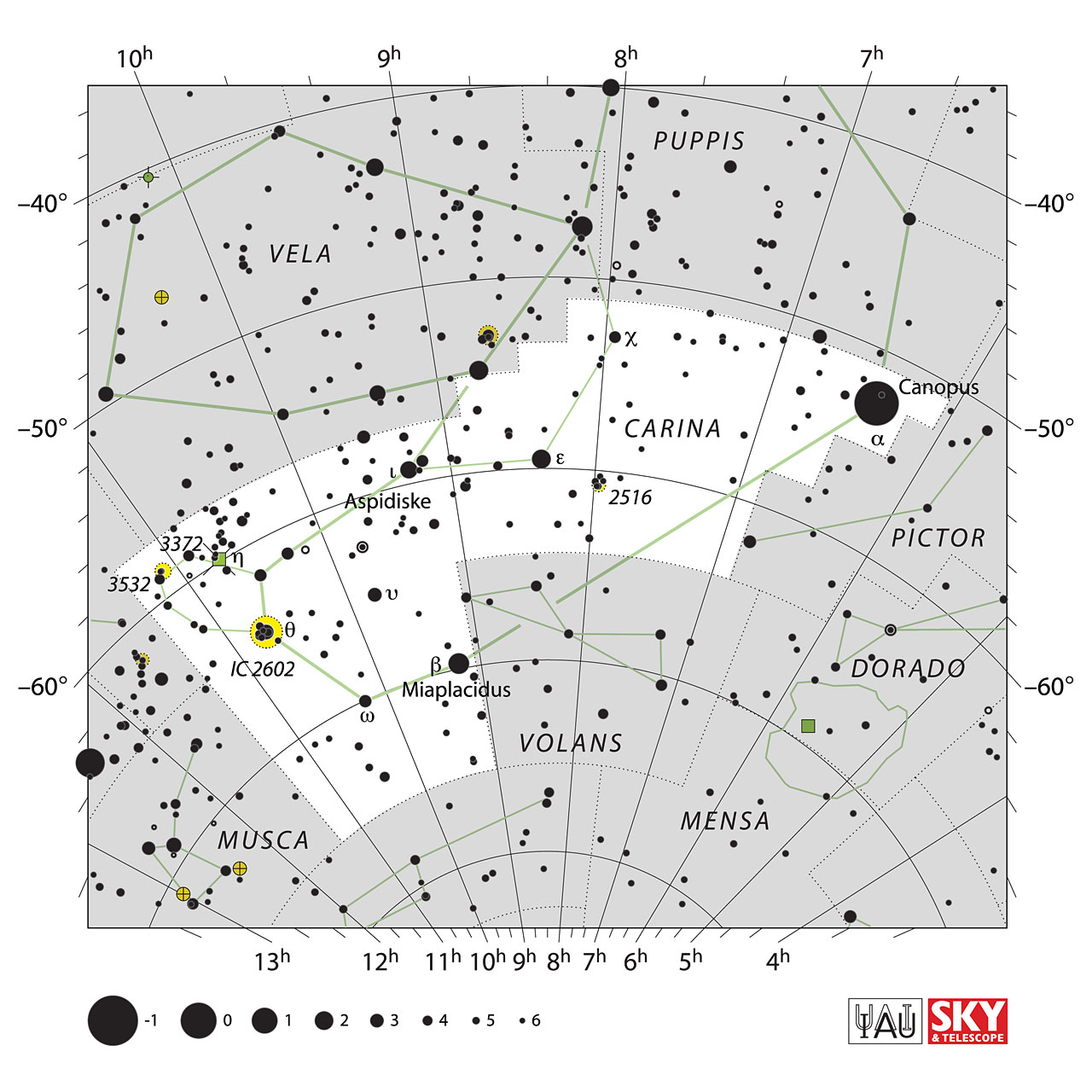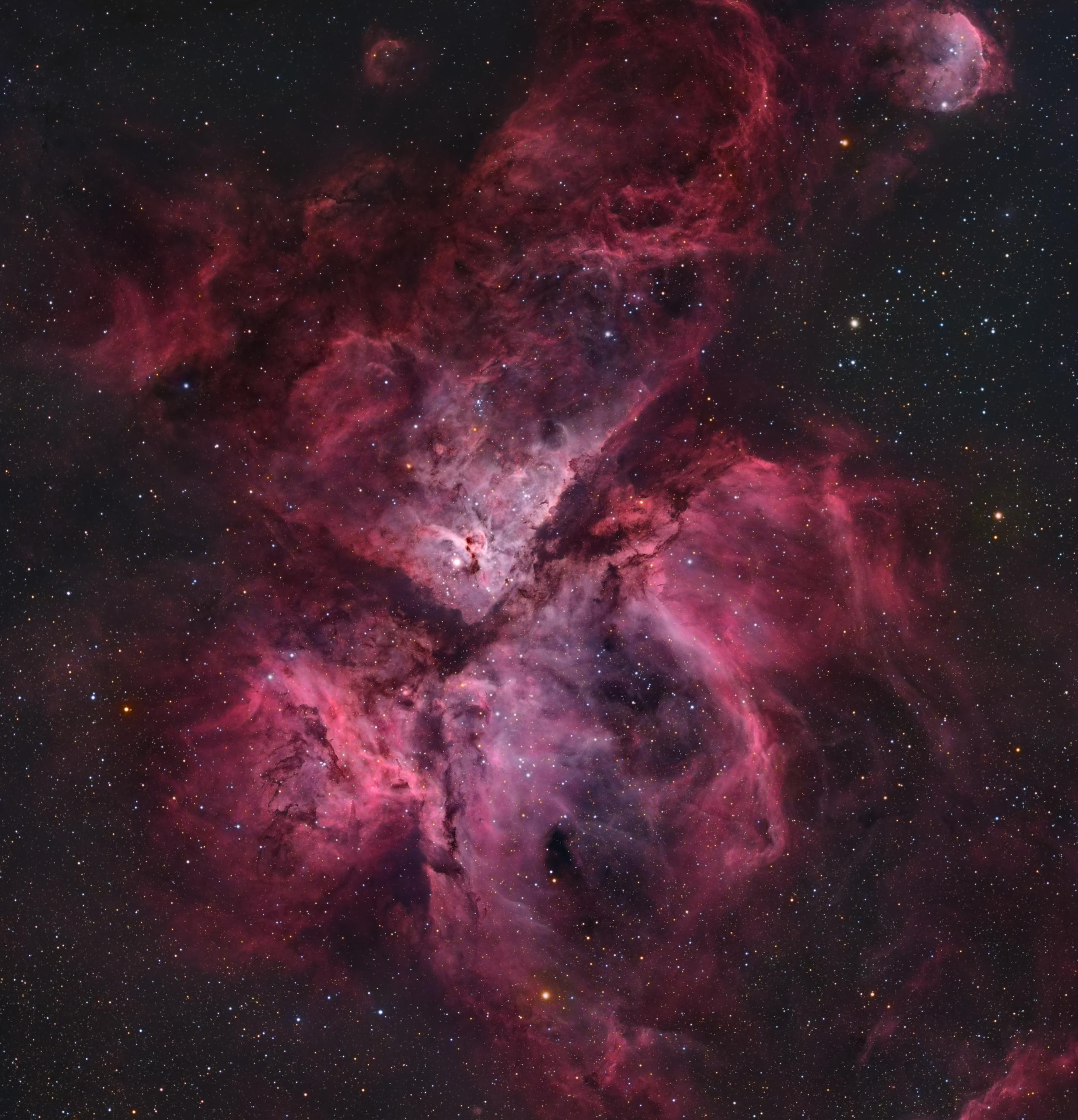Carina, Latin for "the keel" or "the hull," is a constellation in the southern celestial hemisphere. Representing the keel of the mythical ship Argo Navis, Carina is home to several notable celestial objects, including the second-brightest star in the night sky, Canopus. It is rich in nebulae, star clusters, and other deep-sky wonders.
- astronomy
- constellation
- IAU
- Argo Navis
- nebula
- star cluster
1. Introduction
Carina, named after the Latin word for "the keel" or "the hull," is a prominent constellation located in the southern celestial hemisphere. It is part of the larger constellation formerly known as Argo Navis, representing the keel of the mythical ship Argo from Greek mythology. Carina is renowned for its striking visual features, including the second-brightest star in the night sky, Canopus, which serves as a prominent marker in the southern sky.
The celestial coordinates of Carina position it between approximately 6h 00m and 10h 00m of right ascension and between −60° and −30° of declination. This places Carina in close proximity to other prominent southern constellations such as Vela, Puppis, and Centaurus. Its location near the celestial south pole makes Carina visible from latitudes south of approximately 20 degrees north, offering spectacular views to observers in the southern hemisphere (Figure 1).
Characterized by its association with the legendary ship Argo Navis, Carina boasts a wealth of celestial wonders, including nebulae, star clusters, and variable stars. One of its most iconic features is the Eta Carinae Nebula, a sprawling emission nebula known for its intricate structure and dazzling colors. Within this nebula lies the enigmatic star Eta Carinae, one of the most massive and luminous stars known to astronomers. Carina is also home to numerous open star clusters, including the famous Southern Pleiades, which resembles its northern counterpart in Taurus. These clusters serve as stellar nurseries, hosting young stars that illuminate their surroundings with their brilliance. Additionally, Carina contains several notable variable stars, including the luminous blue variable P Carinae and the eruptive variable star S Carinae.

Figure 1. IAU chart of Carina. Source: https://www.iau.org/static/archives/images/screen/car.jpg. Credit: IAU and Sky & Telescope. Reproduced under CC BY 4.0 license.
2. Historical Background and Mythology
Originally part of the larger constellation Argo Navis, Carina represents the keel or hull of the legendary ship Argo. In Greek mythology, the ship Argo played a central role in the quest for the Golden Fleece, a symbol of kingship and authority. The vessel was constructed under the guidance of the goddess Athena and manned by the heroic Argonauts, led by the legendary hero Jason. Carina specifically represents the keel of the ship, which was said to have been crafted from wood from the sacred forest of the goddess Athena.
The constellation's association with maritime lore extends beyond Greek mythology. The Argo was a prominent feature in the mythology and navigation of ancient cultures, including those of the Mediterranean and Near East. It was often depicted in ancient artwork and served as a symbol of exploration, adventure, and the journey of the human spirit.
During the 18th century, French astronomer Nicolas Louis de Lacaille formally divided the Argo Navis constellation into smaller, more manageable sections, including Carina, Vela, Puppis, and Pyxis. Lacaille named Carina after the Latin word for "keel," reflecting its mythological association with the ship's hull.
Today, Carina remains an important part of the celestial landscape, offering astronomers and stargazers a glimpse into both ancient mythology and the history of navigation and exploration. Its connection to the heroic tales of the Argonauts and the quest for the Golden Fleece adds depth and intrigue to its celestial presence, serving as a reminder of humanity's enduring fascination with the stars and the stories they inspire.
3. Notable Stars
Canopus (Alpha Carinae): Canopus is the second-brightest star in the night sky, surpassed only by Sirius in the constellation Canis Major. It is a supergiant star located approximately 310 light-years away from Earth and shines with a visual magnitude of approximately -0.72. Canopus holds great cultural and navigational significance, particularly in the southern hemisphere, where it serves as a prominent marker for celestial navigation.
Canopus is one of the largest and most massive stars known in our galaxy. It has a radius estimated to be around 71 times that of the Sun, making it approximately 71 times larger in diameter. Additionally, Canopus is thought to have a mass around 8 to 9 times that of the Sun, indicating its immense gravitational influence and stellar power. Canopus is believed to be in the latter stages of its stellar evolution. As a supergiant star, it has exhausted its nuclear fuel in its core and has expanded to a massive size, eventually leading to its eventual fate as a supernova. However, Canopus is not currently exhibiting any signs of imminent supernova activity and is expected to remain stable for millions of years before undergoing its final explosive phase.
Avior (Epsilon Carinae): Avior, also known as Epsilon Carinae, is a binary star system located in the constellation Carina. It consists of two stars, Avior A and Avior B, with Avior A being the brighter of the two. Avior A is a spectroscopic binary star, meaning that its companion is detected indirectly through variations in its spectral lines. Avior shines with a visual magnitude of approximately 1.86 and is approximately 630 light-years away from Earth.
Miaplacidus (Beta Carinae): Miaplacidus, designated as Beta Carinae, is a bright star located in the southern constellation Carina. It is a blue-white subgiant star with a visual magnitude of approximately 1.69 and is situated approximately 111 light-years away from Earth. Miaplacidus is notable for its rapid rotation, which causes it to exhibit a flattened shape at its poles. This rapid rotation contributes to its high luminosity and spectral characteristics.
4. Deep-Sky Objects
Eta Carinae Nebula: The Eta Carinae Nebula, also known as the Carina Nebula or NGC 3372, is one of the largest and brightest nebulae in the night sky. Located approximately 7,500 light-years away from Earth, this massive emission nebula spans over 300 light-years in diameter and is visible to the naked eye from dark sky locations. The nebula is illuminated by the light of young, massive stars embedded within its clouds, including the enigmatic star Eta Carinae. Eta Carinae itself is one of the most massive and luminous stars known, undergoing periodic outbursts and eruptions that contribute to the nebula's complex structure and dynamic appearance (Figure 2).

Figure 2. Long exposure photograph of the Carina Nebula along with NGC 3324, taken from the Kalahari Desert in Namibia. North is up. Source: https://commons.wikimedia.org/wiki/File:Carina_Nebula_by_Harel_Boren_(151851961,_modified).jpg. Harel Boren, CC BY-SA 4.0, via Wikimedia Commons.
Southern Pleiades (IC 2602): The Southern Pleiades, also known as IC 2602 or the Theta Carinae Cluster, is an open star cluster located in the constellation Carina. Resembling its northern counterpart in Taurus, the Southern Pleiades is a stunning sight in the southern hemisphere, composed of dozens of hot, young stars surrounded by glowing gas and dust. The cluster is relatively young, with an estimated age of around 50 million years, and is situated approximately 479 light-years away from Earth. The Southern Pleiades serves as a beautiful example of stellar formation and evolution within the Milky Way galaxy.
Wishing Well Cluster (NGC 3532): The Wishing Well Cluster, also known as NGC 3532, is an open star cluster located in the constellation Carina. Named for its resemblance to coins thrown into a wishing well, this cluster is a dazzling sight in the night sky, composed of hundreds of stars spanning a region of approximately 15 light-years in diameter. The Wishing Well Cluster is relatively young, with an estimated age of around 300 million years, and is situated approximately 1,300 light-years away from Earth. Its bright stars and compact arrangement make it a popular target for amateur astronomers and astrophotographers seeking to capture its beauty.
